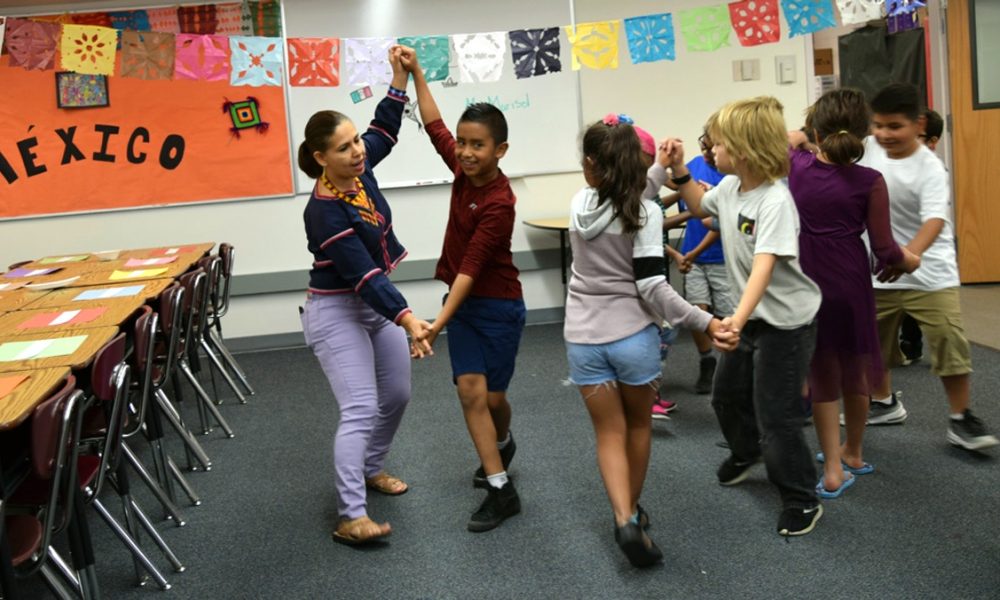
Marisol Ortega teaches students at Alameda Elementary the steps to El Cerro de la Silla. (The Enterprise/Yadira Lopez)
ONTARIO – For four weeks this summer, students at Alameda Elementary School will be tripping over words and dance steps.
Under the guidance of teacher Marisol Ortega del Toro, kids will learn the moves to a traditional Mexican dance in an all-Spanish class. Ortega, a Mexican school teacher, is one of two educators leading a summer class in Ontario as part of the Bi-national Teacher Exchange Program, a partnership between the U.S. and Mexico.
Since 2013 Ontario has hosted two to three Mexican teachers each summer.
“The beauty of this is that it’s an exchange,” said Anabel Ortiz-Chavolla, director of federal programs in the Ontario School District. “We learn from them and they have an opportunity to learn from our system.”
The U.S. Department of Education and the Mexican Ministry of Education devised the program in 1990 as a way to encourage cross-cultural understanding. The state of Oregon is hosting 36 teachers from Mexico this year.
“I’ve always said I’m a citizen of the world, and what better way to do that than by sharing my culture,” said Ortega, a preschool teacher in Jalisco.
In class Thursday she wore colorful beaded jewelry typical of the Huichol, an indigenous group living in the Mexican mountains. She demonstrated the steps to El Cerro de la Silla, a dance originating in Nuevo Leon, Mexico.
All her directions were in Spanish. She estimated that in one class only about half the students were Spanish speakers.
Ortega is animated. She speaks with her hands and makes the kids laugh even when they don’t understand her jokes.
“Cruza los pies” she tells one student while another chimes in to translate: “cross your feet.”
Shy giggles erupted as the kids gripped their partners’ hands before they stomp their feet to the beat of Ortega’s un, dos, un, dos, tres – one, two, one, two, three.
Even though in some classes there are few students who speak Spanish, said Noemí Espinoza-Salazar, she sees the effort they all put in.
“They want to speak, they want to learn,” said Espinoza-Salazar, who is teaching art to students in third to fifth grade at May Roberts Elementary as part of the binational program.
For Espinoza-Salazar, a first-time visitor to the U.S., the experience has been shocking. In a good way.
“I thought that the U.S. completely rejected Mexico and everything of Mexican origin, but that’s not the case,” Espinoza-Salazar told a reporter in Spanish. “I’m leaving with a really good impression.”
An elementary school teacher in her native Jalisco, she’s introducing kids to Mexican muralist Diego Rivera and to the orange monarch butterflies that migrate to Michoacan, Mexico each winter.
Alongside her, the students have made hand-made títeres, or puppets.
Pancha, a red-cheeked puppet with pigtails that Ortega brought from Mexico, keeps things fun.

Noemí Espinoza-Salazar made monarch butterflies out of paper with students at May Roberts Elementary. (The Enterprise/Yadira Lopez)
When students circle around Ortega she introduces Pancha and tells the class that she and the doll are visiting from Mexico and that they’re there to teach the kids how to “bailar.” She wiggles the doll around and the kids quickly guess that they’re about to learn to dance.
Here the students share that they too can speak Spanish like Pancha.
Some raise their hand and say they can speak Arabic, or that they can’t speak Spanish but their mom or dad can.
In Ontario schools, 62% of students in the 2017-2018 school year were Latino, but that doesn’t necessarily mean they’re in touch with the culture, said Ortiz-Chavolla.
For those students, she added, the program is a connection to what they no longer have.
“We also have families who have been here for generations. They might have Martinez in their name but the last person who spoke Spanish was their grandmother,” she said.
Back in the classroom, some of Ortega’s second graders asked their partner “What does that mean?” or “What did she say?”
But when Ortega played the music and asked the class “Ready?” the response she got was a resounding yes in Spanish: “Síííííííííííí!”
Reporter Yadira Lopez: [email protected] or 541-473-3377
For the latest news, follow the Enterprise on Facebook and Twitter.
SUBSCRIBE TO HELP PRODUCE VITAL REPORTING — For $5 a month, you get breaking news alerts, emailed newsletters and around-the-clock access to our stories. We depend on subscribers to pay for in-depth, accurate news produced by a professional and highly trained staff. Help us grow and get better with your subscription. Sign up HERE.




